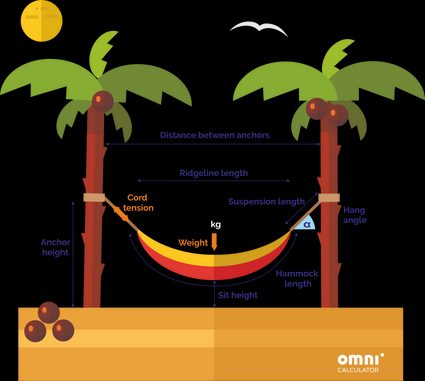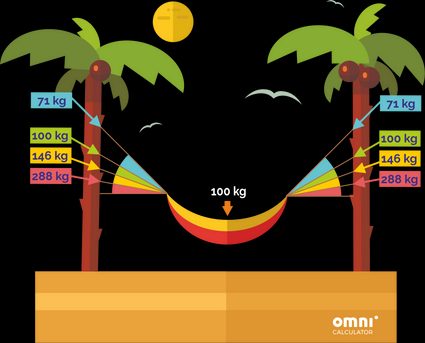Hammock Hang Calculator
As the holidays come closer and the weekends get warmer, the more time you want to spend relaxing in the sun. That is why we've decided to prepare this useful tool — the hammock hang calculator. You're just one step from total chill out — type a few approximate values, and we'll do the rest, finding in the blink of an eye the best way to hang your hammock. Not only can you calculate how to hang a hammock with this tool, but you'll also find several pieces of advice and plenty of useful resources below.
So... what are you waiting for? Hang your hammock in your garden, on your balcony, or between your two favorite trees, and wind down after a long day!
How to hang a hammock

Does the image above, with all of its variables, put you off? Don't worry. It's not as difficult as it looks. With this hammock hang calculator, you don't need to know any trigonometry nor how to calculate force — we do it all for you. Also, we understand that measuring tape is not a must-have on your camping or backpacking weekend — so a rough guess should be enough.
Just follow these simple steps, and we'll help you to hang your dreamy bed:
-
Measure — or estimate — the distance between the anchors. These could be trees, poles, walls, cars... anything that you want to use to hang your hammock. Our calculator is focused on standard hammocks, not hammock chair swings, so a ceiling or branch above your head is not the right choice. Let's pick 14 ft as an example.
-
Enter the preferred sit height. Assuming that you don't want to touch the ground (or have your knees hitting your chin), choose a value in the 16-19 inches range (40-50 cm) — that's about the seat at a chair/sofa height. For instance, let's enter 18 in.
-
Type in the person's weight — the one who's going to relax in a hammock. The weight (and hang angle) influence the forces — cord tension and horizontal tension — sometimes called shear force. Let's assume the person's weight is 175 lbs.
-
Choose the hang angle. This is the angle between the suspension cord and the ground. A 30-degree angle is usually considered the optimal one. It's also the default value in our calculator, but you can select other angles from the dropdown list.
-
Enter the last given value — either ridgeline or hammock length. Ridgeline is the distance between the ends of your hammock when it's set up. Hammock length — or sag — is the length of the curve of your hammock. Usually, the ridgeline is about 83% of the hammock length. Some types of hammocks have a built-in structural ridgeline — it's a cord of a set length connecting both ends. Assume our ridgeline is 9 ft long.
-
There we go! The hammock hang calculator just found many important values! Thanks to the tool, we determined the following:
-
Hammock length (10.4 ft) — an estimate of our hammock length.
-
Anchor height (5.54 ft) — the hang point (how high above the ground the suspension is attached).
-
Suspension length (34.64 in) — the length of the cord/rope/webbing used to hang a hammock. It's the length from the end of the hammock to the hang point. We didn't add the mounting length, as it differs between the suspension systems.
-
Cord tension (175 lbs) — That's the force you could read if you put . It's the resultant force of both the horizontal and vertical tension component (Our net force calculator and Pythagorean theorem calculator may help here).
By ticking the Display more tension values checkbox at the bottom of our tool, you can examine the vertical and horizontal tension components separately. The latter is sometimes called shear force and can be imagined as a force pulling the trees together. Vertical tension always remains about half of the weight of the person in the hammock.
-
Remember that it's not necessary to enter the first five values in order. Our calculators are flexible tools! For instance, if you've chosen the preferred sit height and additionally know the hammock and suspension length, you'll be able to calculate the distance between anchors, as well as a hanging point. Awesome!
Hanging hammock — tips and tricks
In this paragraph, we gathered a few handy pieces of advice:
- As trees are the most popular place from which to hang a hammock, take some time to find the perfect spot. You should look for trees that are 12-17 feet apart. The trees should be sturdy, healthy, and large enough to hold you. Do we need to mention that saplings and young, puny trees are not the best choices?

- The general rule is that we should aim for a hang angle of 30° ∠ — hanging the hammock loosely helps you find the most comfortable position. As everybody is different, your perfect angle may not be 30°, so be sure to try various options. Usually, taller people prefer smaller angles (e.g., 25°), while shorter tend to go for around 40-45 degree angles.

- The ends should be tied at roughly the same height, making a straight horizontal line — you don't want to slide out of the hammock in the middle of the night, do you? Remember that if the ground is uneven, the ends will not necessarily be hung from the same height above the ground.

-
Most people beginning their hammock adventures lay in line with the hammock. This causes their bodies to curve into a banana shape, which may provoke back or knee aches. Laying on the diagonal is usually way more comfortable and helps you maintain a flat position.
-
Learn most useful knots, for example from the . Instead of a knot, you can also use hardware: carabineers, toggles, clips, etc.
-
If you're camping outside, it's usually a good idea to protect yourself from rain 💧 and insects🐛 and other creatures you don't want to share your hammock with 🕷️. Bug netting and a basic tarp will allow you to rest and sleep peacefully. Some insulation may also be necessary if you're not in a particularly warm area.
What else? Just close your eyes, listen to the crickets chirping, and fall into the arms of Morpheus. We hope that with this advice, sleeping in a hammock will be a pleasure.
How to choose your hammock
There are many different articles and blog posts on the Internet, but we'll sum up here three essential features:
- Don't choose a hammock with a spreader bar if you don't want to worry about flipping, spinning, and falling out of your hammock. Just don't.

- The material of a hammock is a crucial factor. Rope hammocks between 🌴two palm trees🌴, with a spreader bar between them — that is a symbol of a carefree, relaxing holiday ☀️ (a totally fake symbol, we must add). A quarter of an hour in such a hammock is usually fine, but a whole night? Forget it! Time and gravity will work against you, and you'll probably experience the phenomenon of the . There are plenty of better options. As a rule of thumb, the material of the hammock should be smooth and comfortable, and it shouldn't leave any marks or dig into your skin.

- The general rule to find proper hammock length is the longer, the better.
Useful resources
In writing this short article, we used a few helpful websites. Check them out!

